Compact, Broadband, and High-Gain Four-Port MIMO Antenna for Future Millimeter Wave Applications
Abstract
1. Introduction
- Novel geometry with simple structure and compact size.
- Ease of fabrication and integration with other circuit components due to simple geometrical structure.
- Operates in wideband with high gain.
- Self-decoupled and offers low mutual coupling without the need of any additional decoupling structure.
- Offers high-performance MIMO parameters meeting the standard limits.
2. Proposed Antenna Design
2.1. Single Element of Antenna
2.2. Four Port MIMO Antenna
3. Proposed MIMO Antenna Results
3.1. Reflection and Transmission Coefficient
3.2. Measured and Simulated Gain
3.3. Radiation Pattern
3.4. MIMO Parameters
3.5. Literature Comparison
4. Conclusions
Author Contributions
Funding
Data Availability Statement
Conflicts of Interest
References
- Hussain, M.; Awan, W.A.; Alzaidi, M.S.; Hussain, N.; Ali, E.M.; Falcone, F. Metamaterials and their application in the performance enhancement of reconfigurable antennas: A review. Micromachines 2023, 14, 349. [Google Scholar] [CrossRef] [PubMed]
- Ahamad, F.T.; Malek, N.F.A.; Roslan, F.S.; Saidin, N.; Islam, M.R.; El Qasem, N. Enhanced Antenna Performance at 3.5 GHz With a Compact and Intelligent Reflecting Surface. IIUM Eng. J. 2024, 25, 179–195. [Google Scholar] [CrossRef]
- Hazim, R.; Qasem, N.; Alamayreh, A. OAM Beam Generation, Steering, and Limitations Using an Intelligent Reflecting Surface. Prog. Electromagn. Res. M 2023, 118, 93–104. [Google Scholar] [CrossRef]
- Sun, G.; Sheng, L.; Luo, L.; Yu, H. Game Theoretic Approach for Multipriority Data Transmission in 5G Vehicular Networks. IEEE Trans. Intell. Transp. Syst. 2022, 23, 24672–24685. [Google Scholar] [CrossRef]
- Dai, M.; Sun, G.; Yu, H.; Wang, S.; Niyato, D. User Association and Channel Allocation in 5G Mobile Asymmetric Multi-Band Heterogeneous Networks. IEEE Trans. Mob. Comput. 2025, 24, 3092–3109. [Google Scholar] [CrossRef]
- Huang, X.; Liu, Z.; Karahan, E.A.; Sengupta, K. Synthesized Design of Millimeter-Wave Low-Loss Wideband Bandpass Filter and Filtering Impedance Transformer in 90-nm (Bi)-CMOS Technology. IEEE J. Microw. 2025, 5, 487–502. [Google Scholar] [CrossRef]
- Zhang, Y.; Wang, X.; Gang, Y.; Wang, J.; Wu, S.; Zhang, P.; Shi, Y. 6G SAGIN Information Transmission Model. IEEE Commun. Mag. 2025, 1, 1–8. [Google Scholar] [CrossRef]
- Kumar, S.; Dixit, A.S.; Malekar, R.R.; Raut, H.D.; Shevada, L.K. Fifth generation antennas: A comprehensive review of design and performance enhancement techniques. IEEE Access 2020, 8, 163568–163593. [Google Scholar] [CrossRef]
- Hussain, M.; Awan, W.A.; Ali, E.M.; Alzaidi, M.S.; Alsharef, M.; Elkamchouchi, D.H.; Alzahrani, A.; Sree, M.F.A. Isolation improvement of parasitic element-loaded dual-band MIMO antenna for mm-wave applications. Micromachines 2022, 13, 1918. [Google Scholar] [CrossRef]
- Qasem, N. Exploring 60 GHz Millimeter-wave Indoor Propagation Path Loss Models and Capacity Enhancement for Modified Indoor Environments. J. Commun. 2024, 19, 340–349. [Google Scholar]
- Chu, H.; Pan, X.; Jiang, J.; Li, X.; Zheng, L. Adaptive and Robust Channel Estimation for IRS-Aided Millimeter-Wave Communications. IEEE Trans. Veh. Technol. 2024, 73, 9411–9423. [Google Scholar] [CrossRef]
- Hongyun, C.; Mengyao, Y.; Xue, P.; Ge, X. Joint Active and Passive Beamforming Design for Hybrid RIS-Aided Integrated Sensing and Communication. China Commun. 2024, 21, 1–12. [Google Scholar] [CrossRef]
- Gemeda, M.T.; Fante, K.A.; Goshu, H.L.; Goshu, A.L. Design and analysis of a 28 GHz microstrip patch antenna for 5G communication systems. Int. Res. J. Eng. Technol. (IRJET) 2021, 8, 881–886. [Google Scholar]
- Hussain, N.; Awan, W.A.; Ali, W.; Naqvi, S.I.; Zaidi, A.; Le, T.T. Compact wideband patch antenna and its MIMO configuration for 28 GHz applications. AEU-Int. J. Electron. Commun. 2021, 132, 153612. [Google Scholar] [CrossRef]
- Kamal, M.M.; Yang, S.; Kiani, S.H.; Sehrai, D.A.; Alibakhshikenari, M.; Abdullah, M.; Falcone, F.; Limiti, E.; Munir, M. A Novel Hook-Shaped Antenna Operating at 28 GHz for Future 5G mmwave Applications. Electronics 2021, 10, 673. [Google Scholar] [CrossRef]
- Ullah, H.; Tahir, F.A. A novel snowflake fractal antenna for dual-beam applications in 28 GHz band. IEEE Access 2020, 8, 19873–19879. [Google Scholar] [CrossRef]
- Naqvi, S.I.; Naqvi, A.H.; Arshad, F.; Riaz, M.A.; Azam, M.A.; Khan, M.S.; Amin, Y.; Loo, J.; Tenhunen, H. An integrated antenna system for 4G and millimeter-wave 5G future handheld devices. IEEE Access 2019, 7, 116555–116566. [Google Scholar] [CrossRef]
- Jung, J.; Awan, W.A.; Choi, D.; Lee, J.; Hussain, N.; Kim, N. Design of High-Gain and Low-Mutual-Coupling Multiple-Input–Multiple-Output Antennas Based on PRS for 28 GHz Applications. Electronics 2023, 12, 4286. [Google Scholar] [CrossRef]
- Choi, D.; Sufian, M.A.; Lee, J.; Awan, W.A.; Choi, Y.; Kim, N. Advanced Metamaterial-Integrated Dipole Array Antenna for Enhanced Gain in 5G Millimeter-Wave Bands. Appl. Sci. 2024, 14, 9138. [Google Scholar] [CrossRef]
- Yousef, B.M.; Ameen, A.M.; Ali, W.A.; Ibrahim, A.A.; Abdelhady, M.A.; Ahmed, A.E. Compact size and wideband 4 × 4 MIMO antenna for 5G NR networks. Phys. Scr. 2024, 99, 125010. [Google Scholar] [CrossRef]
- Zhang, L.; Kou, H.; Pang, Y.; Yang, L.; Zhang, X.; Shang, Z.; Zhang, L. Design of Temperature-Pressure Sensor Based on Slot-Antenna CSRR Integrated for Applications in High-Temperature Environments. IEEE Sens. J. 2024, 24, 27218–27224. [Google Scholar] [CrossRef]
- Ikram, M.; Sharawi, M.S.; Shamim, A. A novel very wideband integrated antenna system for 4G and 5G mm-wave applications. Microw. Opt. Technol. Lett. 2017, 59, 3082–3088. [Google Scholar] [CrossRef]
- Kiouach, F.; Aghoutane, B.; Das, S.; Islam, T.; El Ghzaoui, M.; Madhav, B.T.P. A dual operating (27/38 GHz) high performance 2× 4 MIMO antenna array for 5G new radio applications. Phys. Scr. 2023, 98, 115504. [Google Scholar] [CrossRef]
- Ali, E.M.; Islam, T.; Awan, W.A.; Alzaidi, M.S.; Alkanhel, R.; Elkamchouchi, D.H. Metasurface loaded dual band antenna for high gain on-and off-body communication. Phys. Scr. 2024, 99, 085530. [Google Scholar] [CrossRef]
- Elabd, R.H.; Al-Gburi, A.J.A. Super-compact 28/38 GHz 4-port MIMO antenna using metamaterial-inspired EBG structure with SAR analysis for 5G cellular devices. J. Infrared Millim. Terahertz Waves 2024, 45, 35–65. [Google Scholar] [CrossRef]
- Desai, A.; Bui, C.D.; Patel, J.; Upadhyaya, T.; Byun, G.; Nguyen, T.K. Compact wideband four element optically transparent MIMO antenna for mm-wave 5G applications. IEEE Access 2020, 8, 194206–194217. [Google Scholar] [CrossRef]
- Tiwari, R.N.; Sharma, D.; Singh, P.; Kumar, P. A flexible dual-band 4× 4 MIMO antenna for 5G mm-wave 28/38 GHz wearable applications. Sci. Rep. 2024, 14, 14324. [Google Scholar] [CrossRef]
- Wani, Z.; Abegaonkar, M.P.; Koul, S.K. A 28-GHz antenna for 5G MIMO applications. Prog. Electromagn. Res. Lett. 2018, 78, 73–79. [Google Scholar] [CrossRef]
- Elsharkawy, R.R.; Hussein, K.F.A.; Farahat, A.E. Miniaturized Multi-band Millimeter-Wave Vivaldi Antenna with Performance Optimization at 28 GHz for 5G MIMO Applications. J. Infrared Millim. Terahertz Waves 2024, 45, 208–232. [Google Scholar] [CrossRef]
- Hussain, M.; Rafique, U.; Dalal, P.; Abbas, S.M.; Zhu, Y. A Compact and Wide Band Antenna for Millimeter Wave Applications. In Proceedings of the 2024 IEEE Wireless Antenna and Microwave Symposium (WAMS), Visakhapatnam, India, 29 February–3 March 2024. [Google Scholar]
- Hussain, M.; Zahra, H.; Abbas, S.M.; Zhu, Y. Flexible Dielectric Materials: Potential and Applications in Antennas and RF Sensors. Adv. Electron. Mater. 2024, 10, 2400240. [Google Scholar] [CrossRef]
- Xiang, Z.; Wang, Q.; Nie, X.; Jin, S.; Zhou, J. LSTM-Assisted SINS/2D-LDV Tightly Coupled Integration Approach Using Local Outlier Factor and Adaptive Filter. IEEE Trans. Instrum. Meas. 2025, 74, 8500915. [Google Scholar] [CrossRef]
- Huang, X. Design of Miniaturized SIW Filter Loaded with Improved CSRR Structures. Electronics 2023, 12, 3789. [Google Scholar] [CrossRef]
- Awan, W.A.; Islam, T.; NAlsunaydih, F.; Alsaleem, F.; Alhassoonc, K. Dual-band MIMO antenna with low mutual coupling for 2.4/5.8 GHz communication and wearable technologies. PLoS ONE 2024, 19, e0301924. [Google Scholar]
- Hussain, M.; Abbas, Q.; Gardzi, S.H.; Alibakhshikenari, M.; Falcone, F.; Limiti, E. Ultra-wideband mimo antenna realization for indoor Ka-band applications. In Proceedings of the 2022 United States National Committee of URSI National Radio Science Meeting (USNC-URSI NRSM), Boulder, CO, USA, 4–8 January 2022. [Google Scholar]


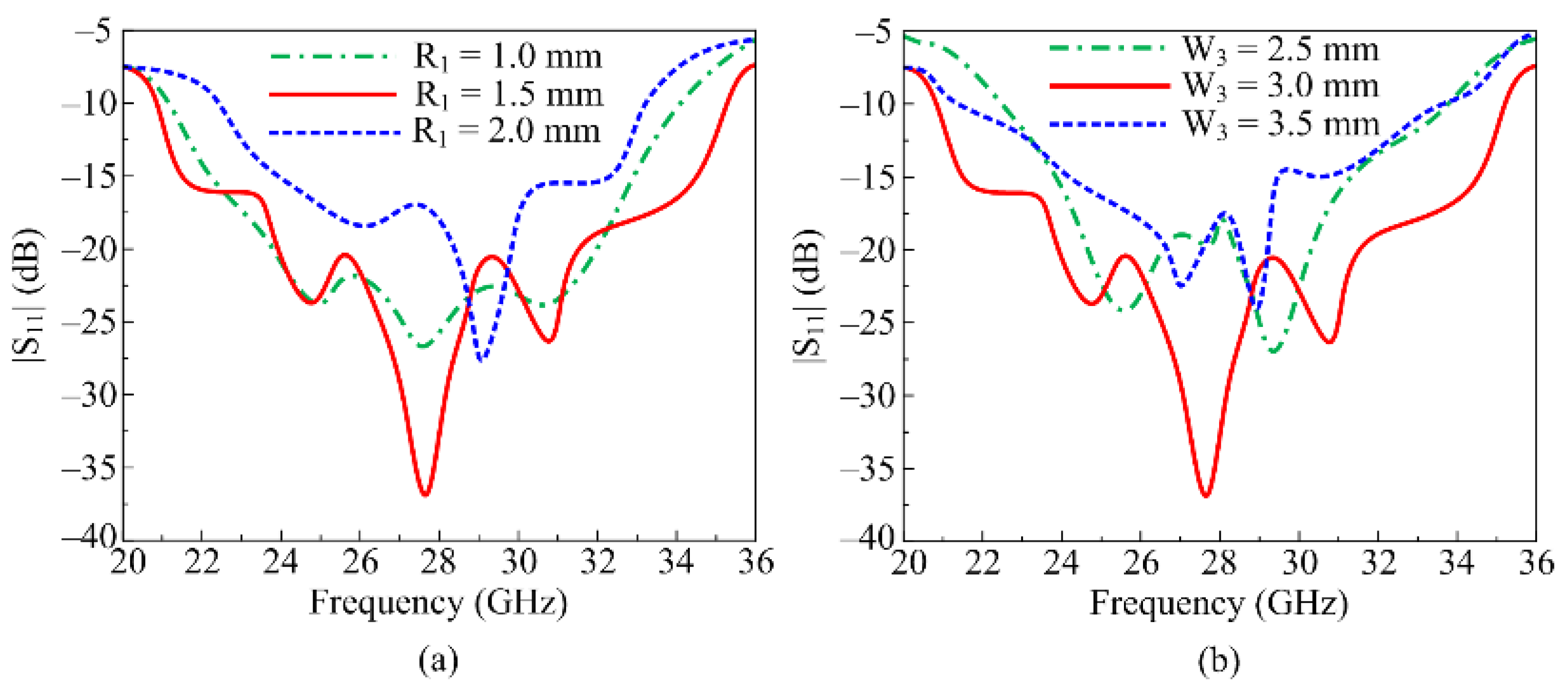
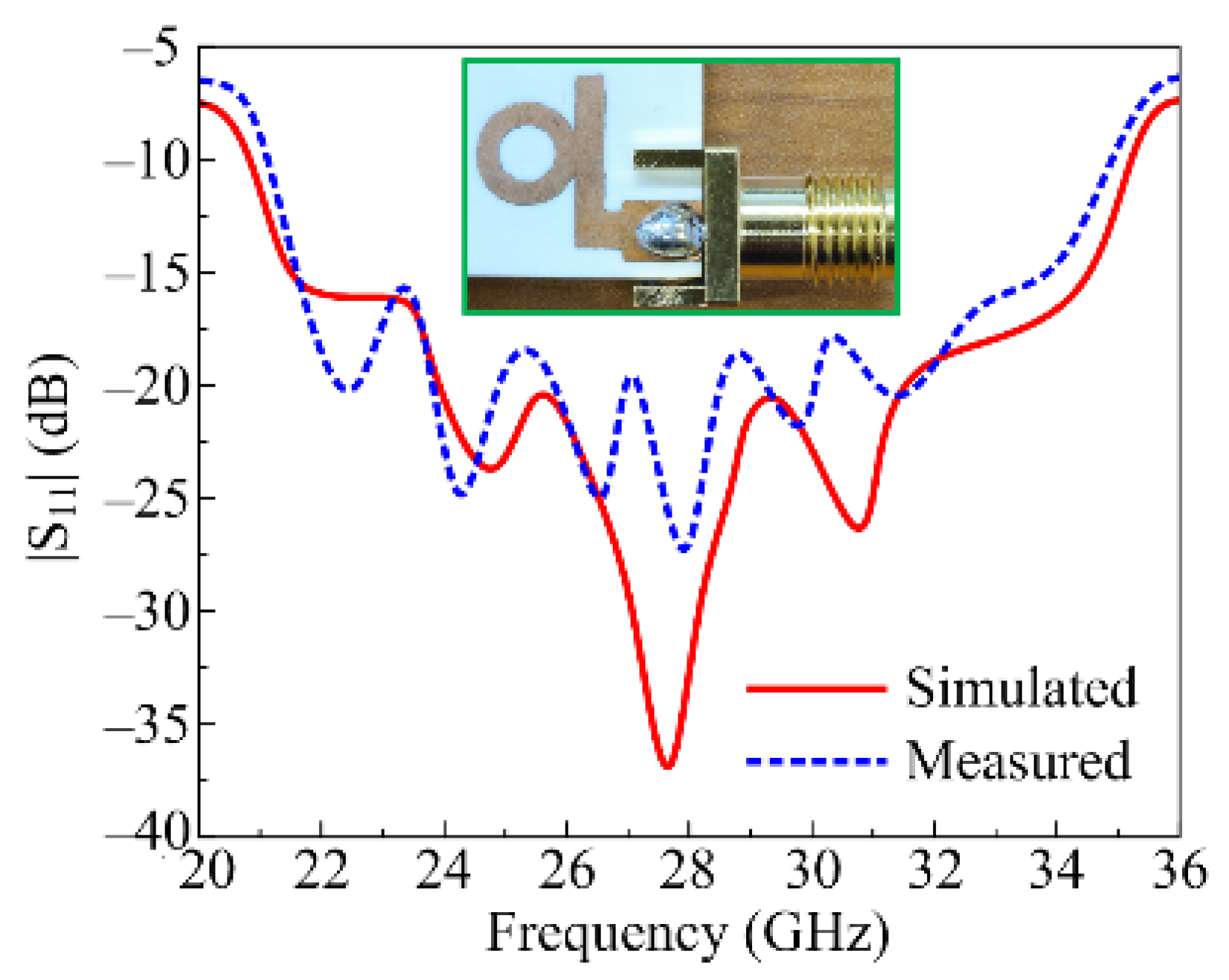
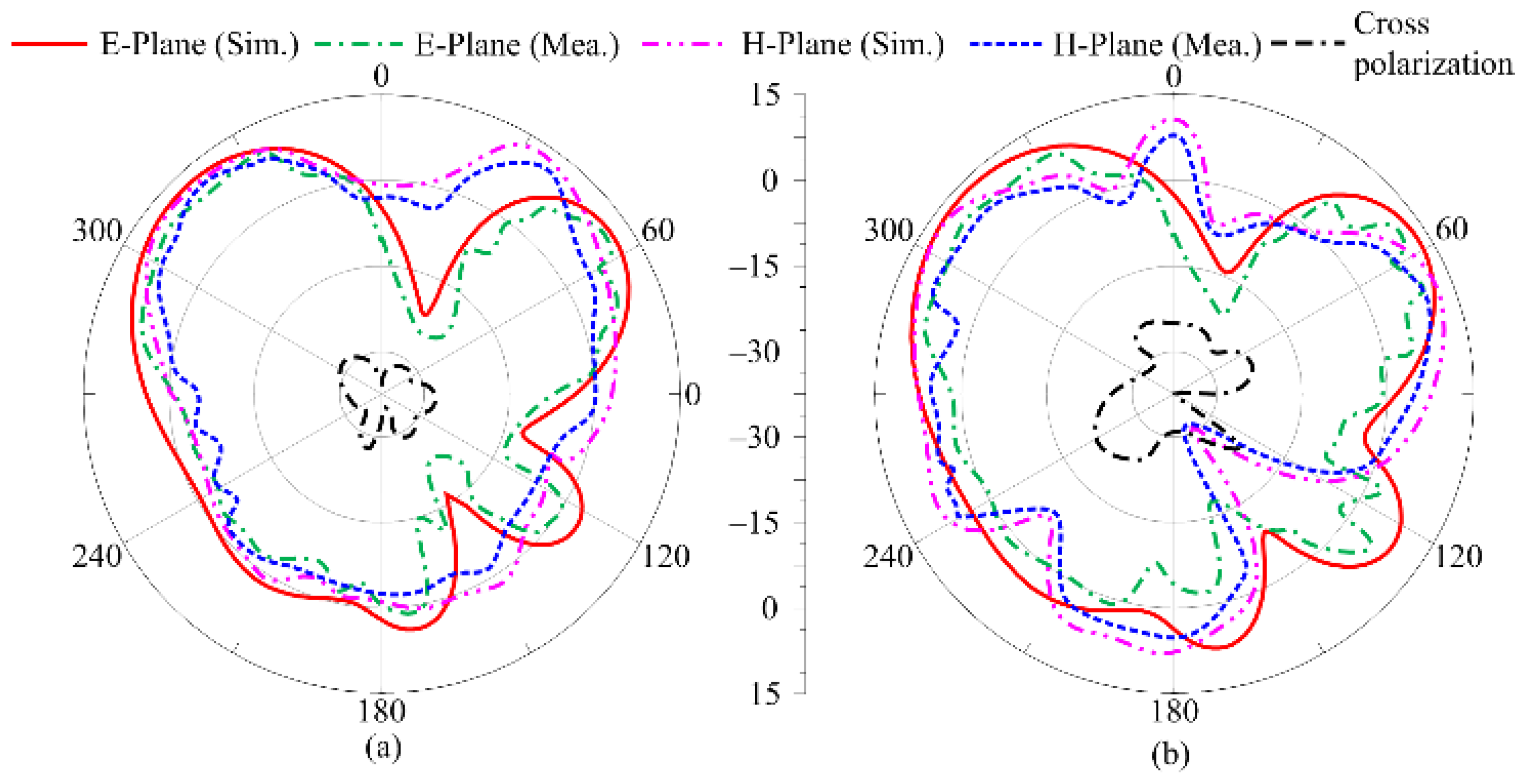
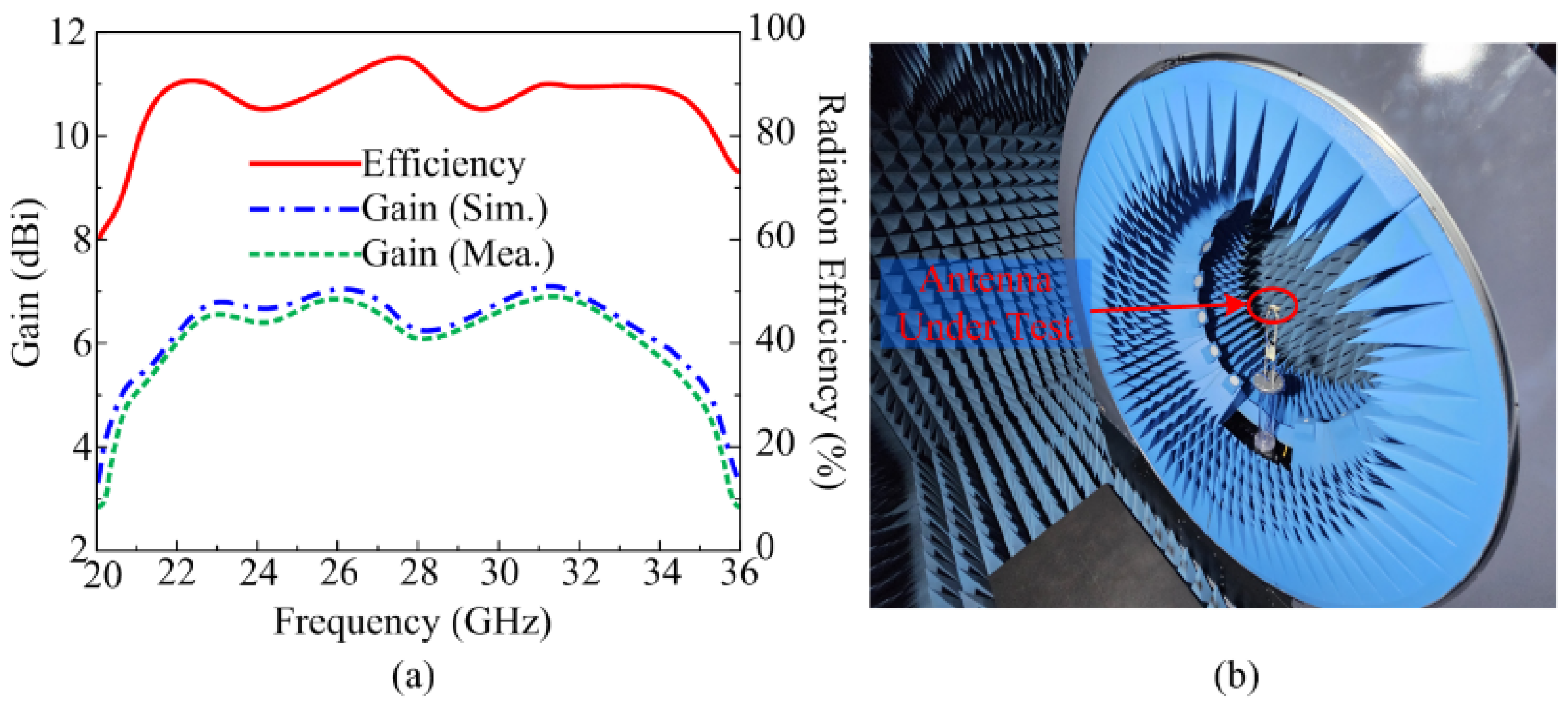

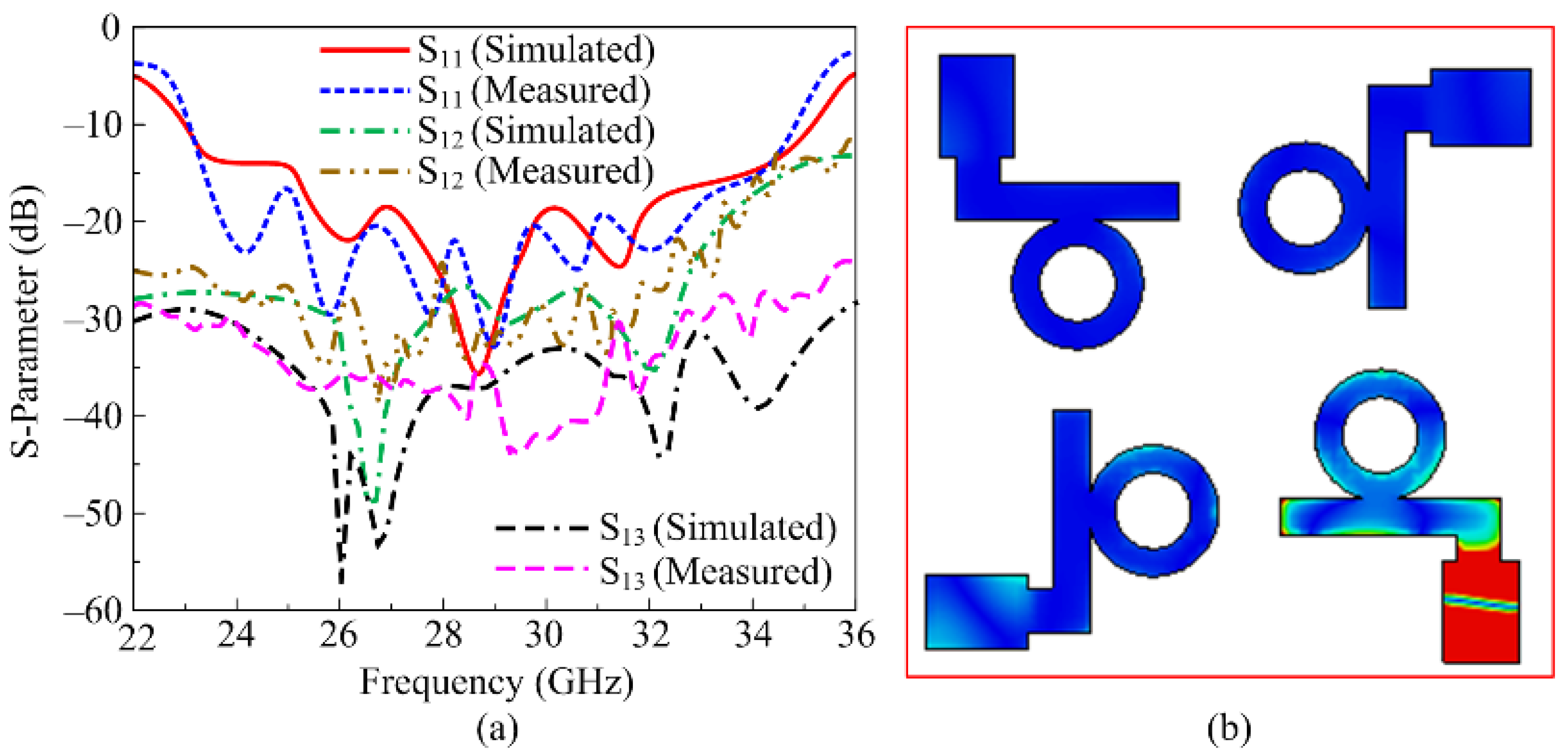
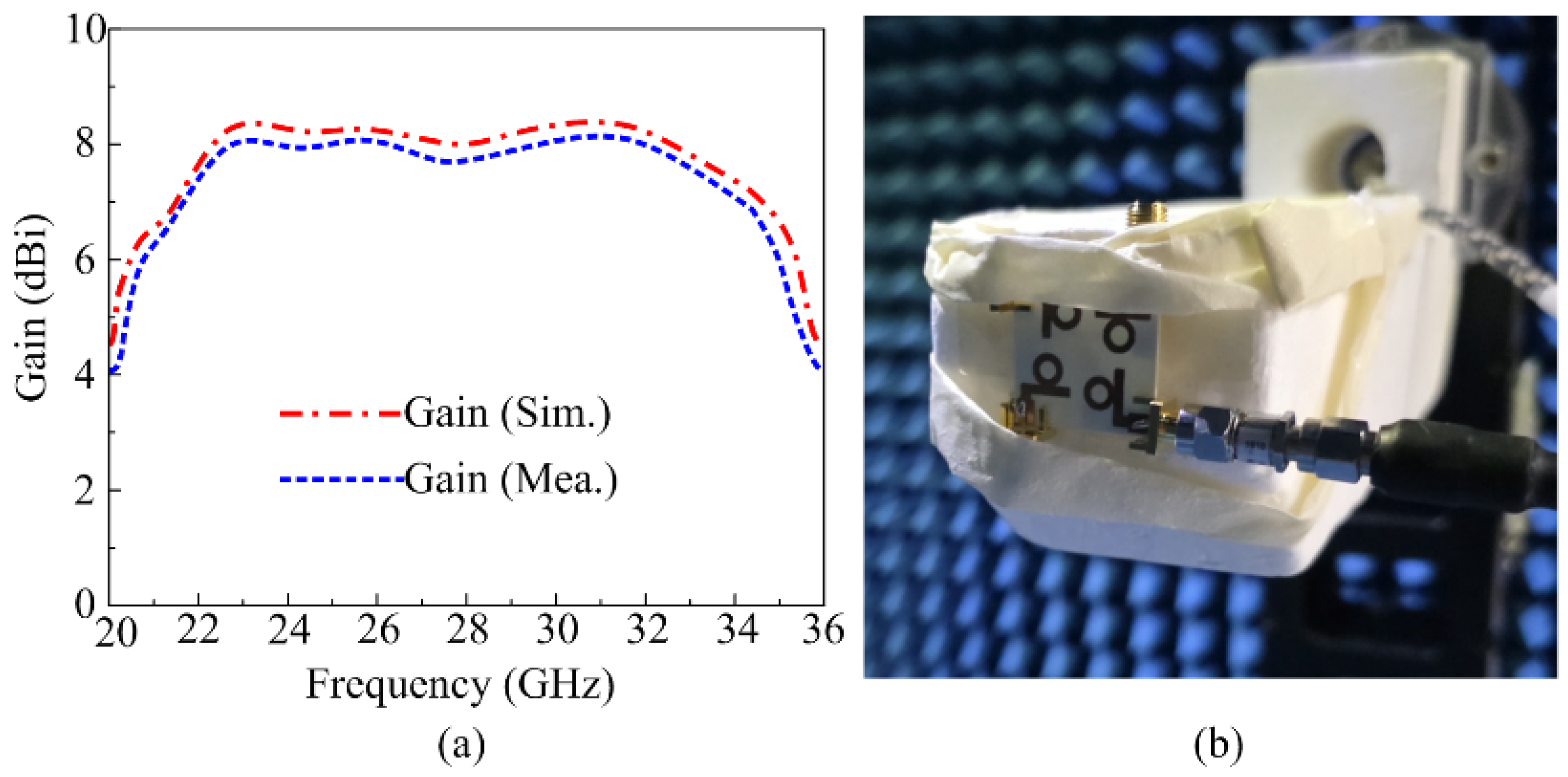
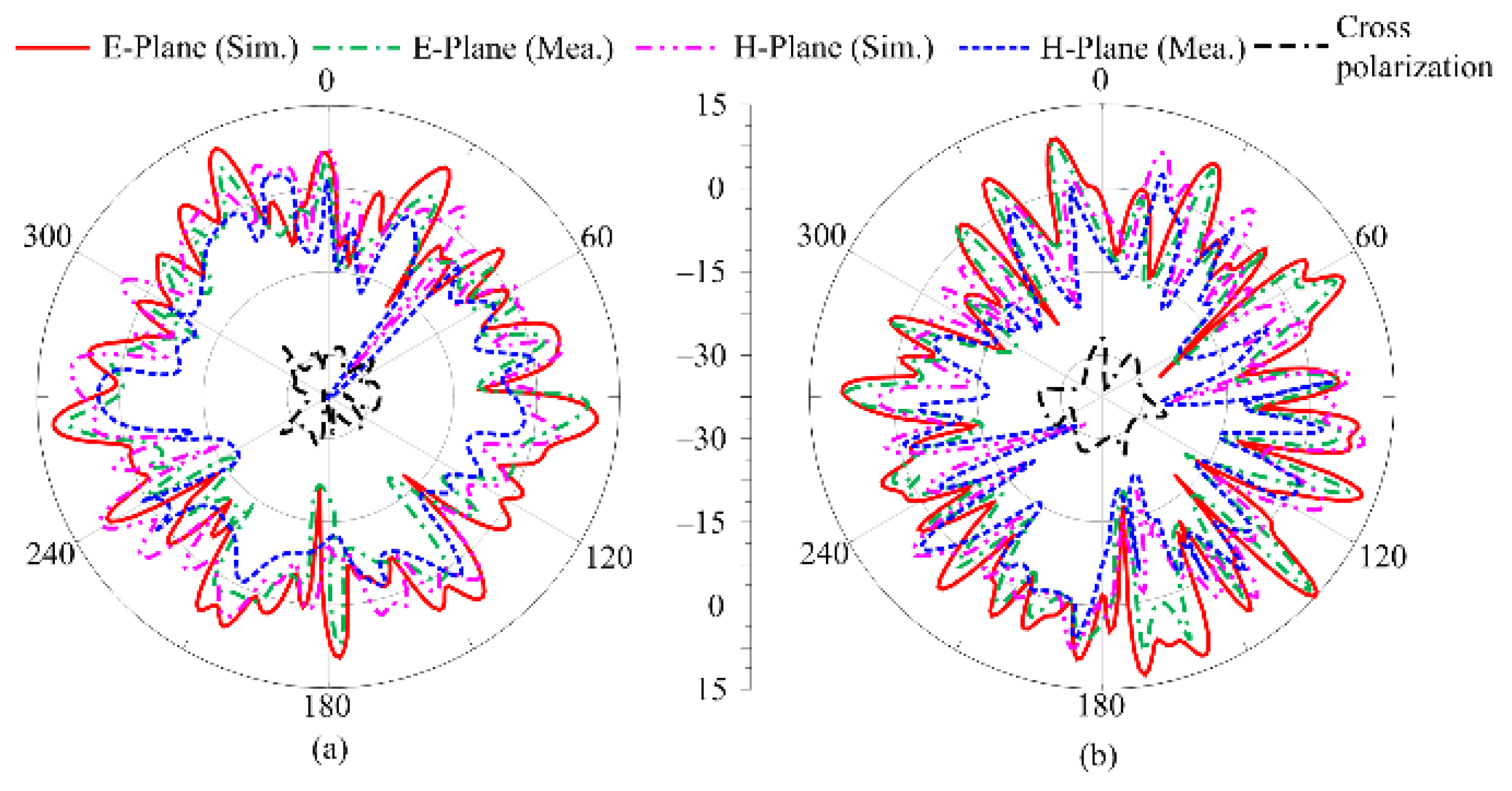
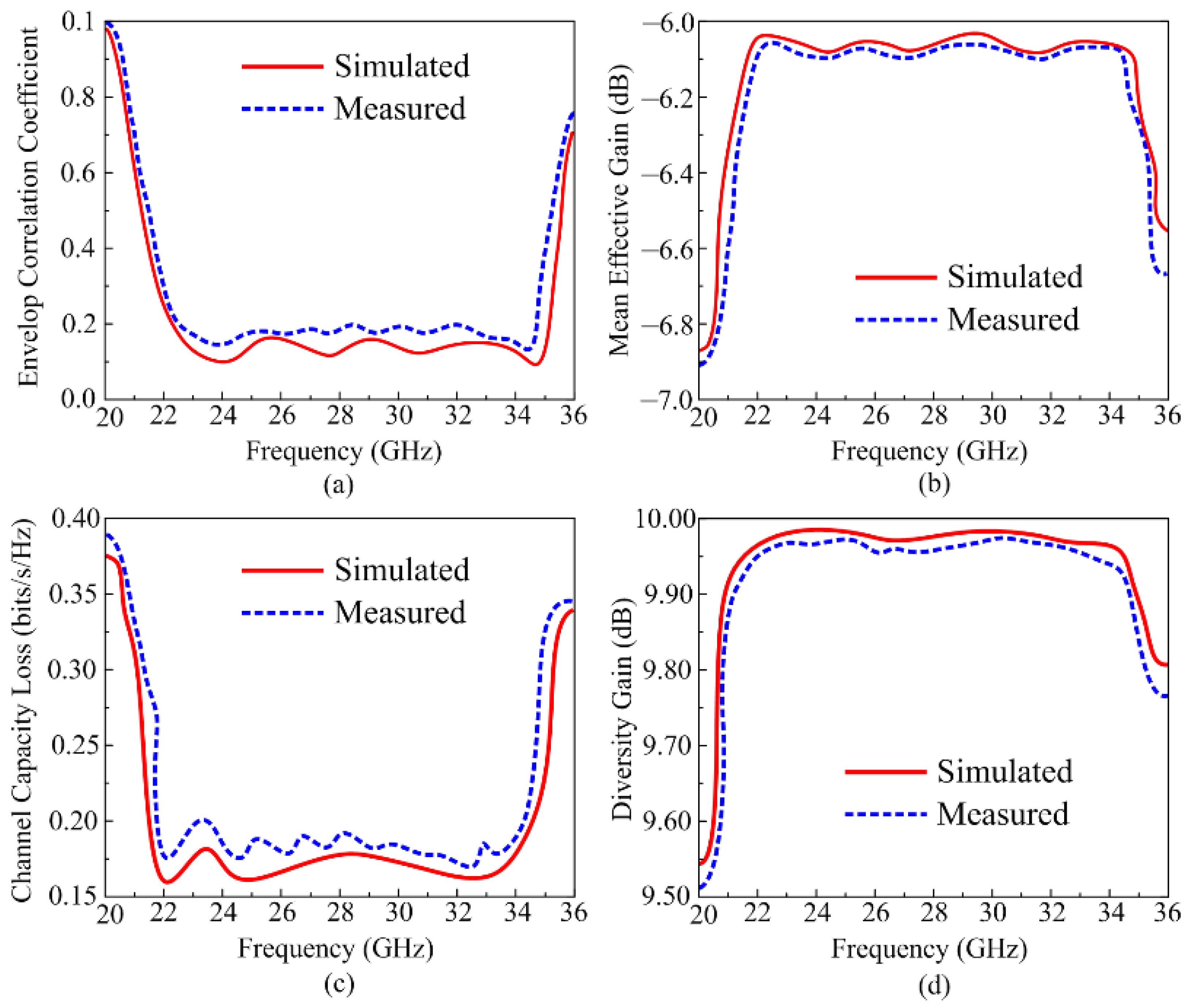
| Ref | Size (mm3) | Bandwidth (%) | Isolation (dB) | Gain (dBi) | Efficiency | ECC | CCL Bit/Hz/sec |
|---|---|---|---|---|---|---|---|
| [16] | 12 × 32 × 1.575 | 5.03 | – | 10.12 | 80 | – | – |
| [17] | 110 × 75 × 0.508 | 17.5 | – | 10.29 | 90 | – | – |
| [18] | 24 × 24 × 1.574 | 20.71 | –33 | 11.4 | 84 | 0.004 * | 0.33 |
| [19] | 23 × 32 × 0.203 | 78 | –28 | 11.21 | – | 0.004 * | – |
| [20] | 24 × 24 × 0.203 | 71.4 | –20 | 4.23 | 89 | 0.5 | 0.25 |
| [22] | 115 × 65 × 0.76 | 4.28 | –30 | 9.65 | 80 | 0.16 | – |
| [23] | 32.4 × 32.8 × 0.8 | 12.86 | –22 | 8.75 | – | 0.003 * | 0.4 |
| [24] | 17.6 × 17.6 × 1.52 | 2.57 | –25 | 8.75 | – | – | – |
| [25] | 24 × 20 × 1.85 | 11 | –16 | 3.7 | 88 | 0.1 | – |
| [26] | 18 × 8.5 × 0.25 | 2.57 | –20 | 7.73 | 88 | 0.03 * | 0.15 |
| [27] | 31 × 48 × 0.254 | 17.9 | –20 | 8.9 | 94 | 0.0015 * | – |
| [28] | 45 × 45 × 0.25 | 24.64 | –30 | 10 | 86 | – | – |
| This work | 24 × 24 × 0.79 | 46.6 | –25 | 11.5 | 84 | 0.2 | 0.17 |
Disclaimer/Publisher’s Note: The statements, opinions and data contained in all publications are solely those of the individual author(s) and contributor(s) and not of MDPI and/or the editor(s). MDPI and/or the editor(s) disclaim responsibility for any injury to people or property resulting from any ideas, methods, instructions or products referred to in the content. |
© 2025 by the authors. Licensee MDPI, Basel, Switzerland. This article is an open access article distributed under the terms and conditions of the Creative Commons Attribution (CC BY) license (https://creativecommons.org/licenses/by/4.0/).
Share and Cite
Mousa Ali, E.; Gunamony, S.L.; Alawad, M.A.; Alharbi, T.E. Compact, Broadband, and High-Gain Four-Port MIMO Antenna for Future Millimeter Wave Applications. Micromachines 2025, 16, 558. https://doi.org/10.3390/mi16050558
Mousa Ali E, Gunamony SL, Alawad MA, Alharbi TE. Compact, Broadband, and High-Gain Four-Port MIMO Antenna for Future Millimeter Wave Applications. Micromachines. 2025; 16(5):558. https://doi.org/10.3390/mi16050558
Chicago/Turabian StyleMousa Ali, Esraa, Shine Let Gunamony, Mohamad A. Alawad, and Turki Essa Alharbi. 2025. "Compact, Broadband, and High-Gain Four-Port MIMO Antenna for Future Millimeter Wave Applications" Micromachines 16, no. 5: 558. https://doi.org/10.3390/mi16050558
APA StyleMousa Ali, E., Gunamony, S. L., Alawad, M. A., & Alharbi, T. E. (2025). Compact, Broadband, and High-Gain Four-Port MIMO Antenna for Future Millimeter Wave Applications. Micromachines, 16(5), 558. https://doi.org/10.3390/mi16050558








